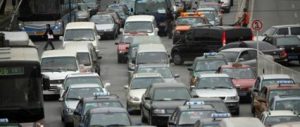At its founding, the People’s Republic of China reserved a special place for bicycles. Targets for manufacturing bikes and building bike lanes were included in the first Five-Year Plan. China was one of the world’s great bike countries – and, even now, it remains so. But a long thriving two-wheeled culture faces a grave and imminent threat from cars.
When the Chinese Communist Party took power in 1949, the United States had already initiated the systematic dismantling of its grand urban transit networks. Tram lines that had stitched together cities – even those now synonymous with sprawl, such as Los Angeles and Phoenix – made way for buses, which in turn made way for cars. Decades would pass before many American cities began to rebuild the transit systems they had destroyed.
Now, these two countries – one whose love affair with cars has only just begun; the other whose relationship with automobiles is long and devoted – are working to secure a future for bikes.
Wheeling downhill in China
“In China, and in many parts of Asia, the bicycle used to be the dominant mode of transportation. …The automobile has become king in the way that we made the automobile king here in California,” said David Chiu , president of the San Francisco Board of Supervisors, during a panel discussion in San Francisco, co-organised by chinadialogue and the Asia Society Northern California.
The challenge in China is to staunch the decline of biking at a time when cars are remaking cities and a growing middle class is trading two wheels for four. Yan Xing, another panelist and a researcher with the University of California Davis Institute of Transportation Studies, set the scene: in 2009, some 45% of trips were made by bike in China; by contrast, in the United States, it was 1%. However, Chinese car ownership surged from 4 million in 1998 to 35 million in 2008, according to the National Bureau of Statistics of China, and bicycle ownership dropped from 1.9 to 1.1 bikes per household between 1995 and 2005. In the 10 years to 2000, bicycling as a percentage of total trips dropped in many of China’s major cities – from 60% to 40% in Beijing and down to 20% in Shanghai and Guangzhou.
Xing recounted one city’s plan to reverse the tide. Hangzhou, on China’s east coast, borrowed a model used by cities worldwide to build a biking culture: bicycle sharing. Fifty thousand bikes are available to rent at 2,000 service stations; the stations are positioned to link bikes with public transit. The stations are convenient, located every 300 metres, and the bikes cheap. Trips under an hour are free, while those of one to two hours cost 1 yuan (US$0.15). The bikes are rented 250,000 times each day, avoiding some 62,000 trips by car.
The scale of the challenge in Hangzhou is formidable: the city is a provincial capital with six million inhabitants. But securing a future for bikes in the megacity of Guangzhou will be harder still. The third largest city in mainland China, Guangzhou is home to 14 million residents. In 1984, Guangzhou was one of 14 coastal cities opened up to overseas investment. Predictably, its economy boomed.
In the boom, bikes went bust. Trips by bike plunged to 11% (compared to 43% in Hangzhou), according to a Tongji University study. As of 2009, Guangzhou had not built a new bike lane in a dozen years. Instead, Guangzhou made way for cars, adding 300,000 to its roads each year.
Bikes weren’t just physically displaced in Guangzhou; decisions by city officials made it more difficult and less convenient for the cyclists who remained. Cyclists were barred from many routes. Bikes were called unsafe and outdated. Some politicians even advocated a bike ban and were able to ban motorcycles for similar reasons.
Remaking Zhongshan Avenue
City officials in Guangzhou, explained Colin Hughes, another speaker at the San Francisco event, soon realised three things: their city’s air quality was now among the worst in the world; they couldn’t build their way out of traffic congestion – new roads were only making the problem worse; and Guangzhou was becoming a not very nice place to live.
Hughes, an independent urban planning consultant based in San Francisco, was part of a team from the Institute for Transportation and Development Policy (ITDP) tasked with helping the city of Guangzhou rethink its transportation infrastructure. They started with the most congested corridor of the city, Zhongshan Avenue, the heart of Guangzhou’s commercial district.
Hughes and the ITDP team re-envisioned a 22.5-kilometre stretch of Zhongshan Avenue, starting conceptual planning work in 2005 and completing the first phase of the revamp in 2010. Gone was the 12-lane free-for-all that left cars, buses and bikes fighting for right of way. In its place: a three-lane Bus Rapid Transit (BRT) corridor, six lanes for cars (three each for in- and out-bound traffic) and two separated bike lanes.
As in Hangzhou, a bike-sharing system was built that feeds into transit. In the first phase, 5,000 rental bikes were installed at 113 stations along Zhongshan Avenue, with two expansions scheduled to complete by spring 2012. The city also built 40 two-tiered, weather-protected, bike parking structures.
Early results are impressive. Bike trips have jumped 50% in one year, to 35,000 per day. The bike-sharing system alone generates 20,000 daily trips. Carbon emissions have been slashed by 1,500 tonnes annually. And the corridor has become a showpiece: Guangzhou officials host tours for mayors from Asia and beyond, who are considering similar projects in their own cities.
Hughes cautioned that considerable challenges remain. There is a lack of a strong vision and policy support for sustainable urban transport at the national level in China, he said. However, he added: “If these changes can happen on the dirtiest, most congested, least bicycle-friendly arterial in one of the biggest, fastest growing, formerly most automobile-centric cities in China, then it can happen anywhere.”
Sustainable streets in San Francisco
In Guangzhou, the challenge was to re-introduce bikes to a cityscape that had once welcomed them. In San Francisco, already one of America’s biking cities, the challenge is to push, by American standards, the boundaries of the possible. “Here in San Francisco we like to think of ourselves on the cutting edge of everything. We have an awful long way to bike before we catch up with some of our greatest cities,” said David Chiu.
Chiu noted that 8% of trips in San Francisco are now made by bike – a little short of the 2010 target of 10%. The new goal, enshrined in city policy, is much more ambitious: 20% of all trips are to be made by bike by 2020. Chiu said money should not be the limiting factor: you can build almost 100 kilometres of bike lanes for the same price as 1.6 kilometres of urban freeway. More important will be education and outreach – the job of panelist Timothy Papandreou, deputy director of transportation planning in the sustainable streets division of San Francisco’s Municipal Transportation Agency (SFMTA).
San Francisco’s bike network extends 72 kilometres. Papandreou said the near-term goal is to increase this to 126 kilometres, and to expand bike access to bridges and transit.
Papandreou pointed to some initial successes: San Francisco was the first American city to install bike racks on all buses; bike “corrals”, which replace car parking with bike racks, are going up around the city; and bikes are now allowed on the Golden Gate Bridge.
But to reach its sustainable mobility goals, which will require car trips be cut by half – to 30% by 2030 – San Francisco will need help from its residents. Advocacy and leadership will be key, said Papandreou, as will education. Activists such as the 12,000-member San Francisco Bicycle Coalition – the largest group of its kind in the world – will play a critical education role, Papandreou said.
The city will continue to invest in bike infrastructure. San Francisco, with its neighbours to the south, San Mateo and San Jose, will soon launch the first phase of a regional bike-sharing programme, with bike stations clustered next to light-rail stops.
Transit planners are encouraged by one early accomplishment – persuading commuters heading downtown to forsake cars for bikes. As in Guangzhou, where Zhongshan Avenue was re-made to favour transit and bikes, San Francisco officials transformed Market Street, the hub of the city’s financial district, into a haven for bikers. “In 2005, we had three times as many cars as bikes on Market Street; in 2010, we had three times as many bicyclists as we did cars,” said Papandreou.
But even in San Francisco, bastion of progressive politics and home to enlightened elected officials, engineers and planners, securing a future for bikes is not easy, said Papandreou: “We need a lot more help from the public, business and the community, to say ‘yes, I understand and I want that’.”
Justin Gerdes is a freelance journalist based in California.
Homepage image by Mike
How has bike-sharing fared in Washington, DC? Read our guest blog post from local resident Melody Wilson.


